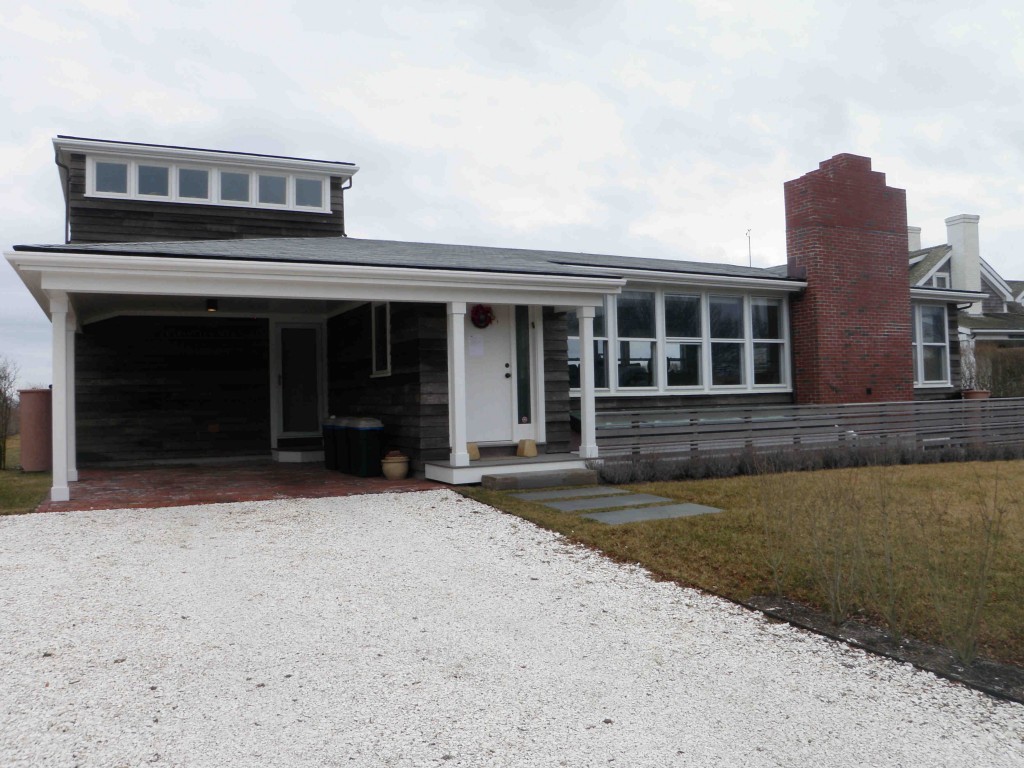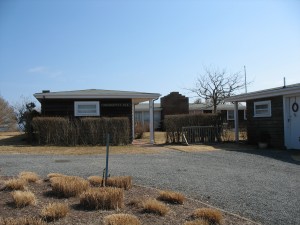
The design of the house at 71 Baxter Road contrasts vividly with the earlier Victorian and Shingle Style houses along the North Bluff of Siasconset. The unornamented one-story L-shaped house with the wide chimney was built for Judge Jesse B. Cunningham and his wife, Caroline, in the summer of 1939. It is one of the first modern houses on the north bluff, with a distinctive design characteristic of the International Style of architecture so designated by Henry-Russell Hitchcock and Philip Johnson in an exhibition of modern architecture at the Museum of Modern Art in New York in 1931. A catalog of the show expounded on the basic tenets of a style that had evolved over the previous decade, among them an emphasis on the horizontal plane, an avoidance of superimposed decoration, and an appreciation of functionality, all characteristics suited to ‘Sconset’s architectural heritage.
 Unfortunately, we have no clues about the personal aesthetic of the Cunninghams—whether they were familiar with current trends in architecture from travels in Europe and the United States, what brought them to ‘Sconset, and what influenced their decision to build their summer cottage in a modern style. Since the house is so markedly different from others on the island , it is probable that it was designed by an architect the Cunninghams knew in Pennsylvania. One of the best known American architects working in the International Style in the 1930s and ‘40s was George Howe of Philadelphia; although there is no evidence that Howe designed the house, it is possible he or an associate created a sketch of the simple cottage for the Cunninghams. Other potential candidates whose work may have influenced the design of 71 Baxter are Frank Lloyd Wright, whose sister, Maginel Wright Enright Barney owned a Nantucket summer home for more than twenty-five years (she sold it in September 1939) and German architect Walter Gropius, founder of the Bauhaus School, and Marcel Breuer , both of whom came to the United States at this time to teach at Harvard. It is conceivable that an associate of one of these well-known architects working in New England in the late 1930s may have had a hand in the design.
Unfortunately, we have no clues about the personal aesthetic of the Cunninghams—whether they were familiar with current trends in architecture from travels in Europe and the United States, what brought them to ‘Sconset, and what influenced their decision to build their summer cottage in a modern style. Since the house is so markedly different from others on the island , it is probable that it was designed by an architect the Cunninghams knew in Pennsylvania. One of the best known American architects working in the International Style in the 1930s and ‘40s was George Howe of Philadelphia; although there is no evidence that Howe designed the house, it is possible he or an associate created a sketch of the simple cottage for the Cunninghams. Other potential candidates whose work may have influenced the design of 71 Baxter are Frank Lloyd Wright, whose sister, Maginel Wright Enright Barney owned a Nantucket summer home for more than twenty-five years (she sold it in September 1939) and German architect Walter Gropius, founder of the Bauhaus School, and Marcel Breuer , both of whom came to the United States at this time to teach at Harvard. It is conceivable that an associate of one of these well-known architects working in New England in the late 1930s may have had a hand in the design.
The property at 71 Baxter changed hands twice before it was purchased by long-term owners Sidney and Dorothy Dillon in 1973. The Dillons, who lived in Oldwick, New Jersey, had five children who attended boarding schools and colleges in the Boston area, so the summer house at Nantucket was a convenient destination for the younger generation. The five siblings, who were given partial shares in the property by their parents, established the Rugosa Cottage Trust in 1995. The Trust sold the property to John Merson and Carol Bunevich in 2004.
The erosion of the North Bluff of ‘Sconset over the last fifty years or more imperiled the house, so plans were made to move it to a safer location on the west side of the lot. In the fall of 2009, the north ell of the house was removed, as was the garage situated near Baxter Road, but the great room was relocated and enlarged following the tenets of the classic International Style. A dominant feature of the west façade of the house, the wide brick chimney was rebuilt, and a kitchen was added to the north end of the great room. Careful attention was paid to all the elements of the design, particularly the horizontal line emphasized by the red cedar clapboard, exterior fences, and interior stair rails. New rooms, like the squat bedroom tower and the basement suite of bedrooms, baths, and sitting area, create nearly the same floor space as the original house in half the footprint. East facing windows on the lower level—made possible by the creation of a sunken patio—and five skylights below grade on the west side, fill the interior with light. Architect Timothy Lindman created the new design and Ted Lambrecht supervised all the work, completing the project in the Spring of 2010.


